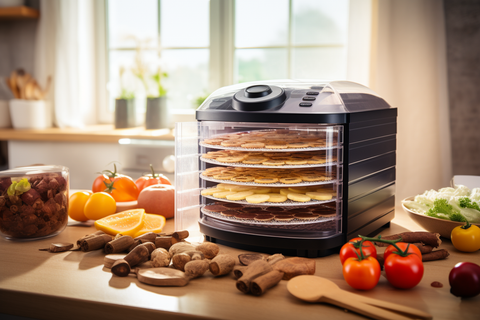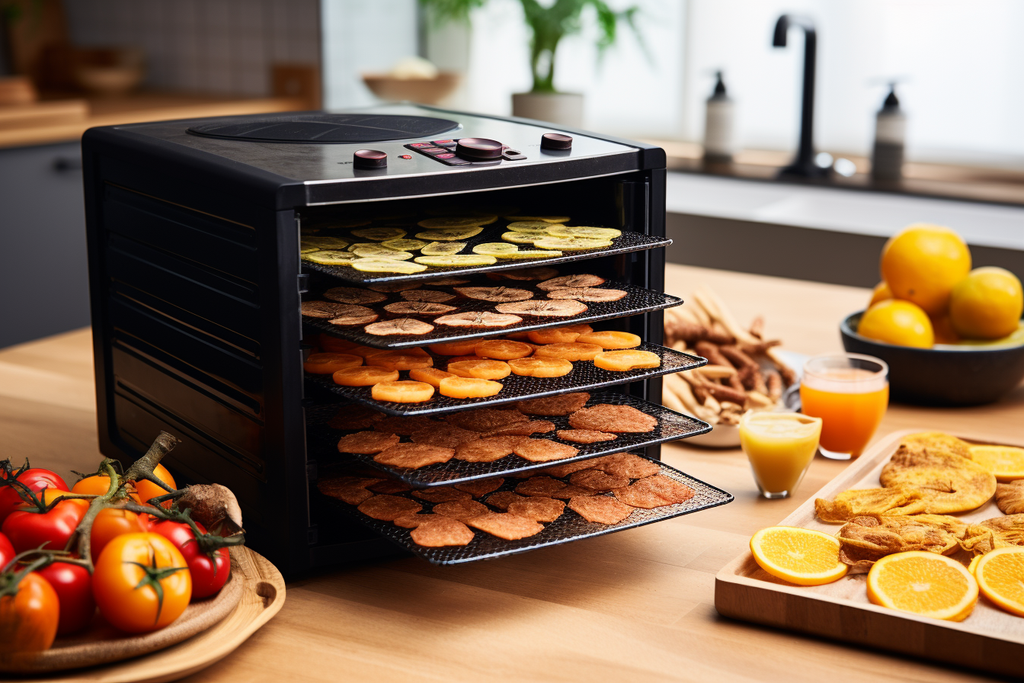Listen up, folks! When dehydrating your food, the burning question on everyone's lips is, "Do you need to rotate the trays?" Well, let me spill the beans and break it down for you.
Picture this: you've got your trusty food dehydrator, the master of oven-like dehydration. You crank up the heat, and as the magic happens, the moisture evaporates, leaving behind delectable, dried goodness. But hold your horses! If you want consistent results, you have to give those trays a spin.
Why, you ask? Simple as pie! Rotating the trays ensures even airflow, letting that heat source circulate like a bakery on fire. No soggy bits, no half-baked surprises. It's all about keeping that water content at bay and achieving perfectly dried delights.
So, don't stick in the mud; grab that vent and give it a whirl! Whether it's fruits, veggies, or even jerky, trust me, rotating those trays will have you basking in the glory of tastiness in no time.
Remember, patience is a virtue, and it might take a bit longer, say, 2-4 hours or even more, but the payoff is worth it, my friends!
The Importance of Rotating Trays in Your Food Dehydrator
If you're rocking a food dehydrator, let me tell you about the importance of rotating trays.
It's as crucial as a secret ingredient in your grandma's recipe!

Picture this:
your Excalibur food dehydrator is fired up, ready to preserve food, and whip up some tasty dried treats.
Here's the deal: while operating a dehydrator, you need to turn your pans every 2-4 hours, just like a master chef gracefully flipping pancakes.
So, grab those oven mitts and rotate your pan like a pro!
Here's why it matters:
- Optimum Dehydration: By rotating your pans while baking, you ensure that every slice of goodness gets evenly dehydrated. No more sad, half-dried bananas or droopy broccoli!
- Even Heating: The heat source is usually at the bottom, and if you don't rotate, the lowest rack will hog all the warmth. We want to avoid hot spots, like those on a scorching summer day, and ensure even heating throughout.
- Shelf Life Savior: When you dehydrate food properly, it extends its shelf life, just like finding that hidden jar of pickles in the back of your cupboard or pantry, still perfectly preserved.
- Say No to Hotspots: Modern ovens may claim to be perfectly calibrated, but they can still have quirks. Without rotating, your baked goods might warm faster in one spot, like a desert mirage, while the rest remains untouched.
- Quick Switch for Success: A simple 180-degree rotation is all it takes to avoid one pesky hotspot and achieve evenly dehydrated deliciousness. Quick, easy, and effective!
So, my friends, remember to rotate your pans like a pro if you want the best results from your food dehydrator and ensure that each slice of dried fruit or veggie becomes a sweet treat with a longer shelf life. Don't let that oven door intimidate you; embrace it!
How to Properly Rotate the Trays in Your Dehydrator for Even Drying
When you're trying to dehydrate your fruits and veggies, you need to master the art of tray rotation. Here's how you do it:
Timing is Key: Set a reminder on your phone or tie a string around your finger to remind yourself to rotate those trays every 2-4 hours. Trust me; you don't want to miss this crucial step.
- The 180-Degree Twist: It's time to give those trays a spin, my friends. Grab them by the handles and rotate them a full 180 degrees. Picture it like a graceful pirouette on the dance floor.
- The Oven Door Shuffle: To achieve even drying, you might need to open the oven door and rotate your trays. Think of it as a sneak peek into a magical world of dehydrating wonders.
- Tackle the Lowest Rack: The lowest rack is like a magnet for heat. If you don't rotate, it'll hog all the warmth like a greedy squirrel hoarding acorns. So, be sure to give it some love and attention.
- High Water Content Beware: Foods with high water content, like cucumbers, are more likely to need a rotation. They can be stubborn, but we won't let them ruin our drying party!
- Save the Day with Airflow: Rotating trays in your food dehydrator is the way to save the day in the world of food preservation. It allows for better air circulation, like a refreshing breeze on a hot summer day.
So, there you have it, my dehydrating comrades. Follow these steps, and you'll be the master of even drying in no time. Remember, a well-rotated tray means perfectly dried foods and happy taste buds. Now, go forth and conquer the dehydration process like a pro.
How Long Does It Take to Dehydrate Food, and Should You Rotate the Trays?
When drying your fruits and veggies in food dehydrators, the drying process can take some time. It's like waiting for a pot of water to boil or watching paint dry, but the result is worth it. Now, for rotating the trays, we must get the even drying we crave. Imagine this: you've got several trays loaded with mouthwatering goodness, and the lowest rack is hogging all the hot air like a greedy squirrel hoarding nuts.
To avoid that, you must rotate the pans 180 degrees, my friend. It's like a little dance for your food, ensuring every slice gets its fair share of drying time. You don't want half of the batch to be perfectly crispy while the other half is still a little squishy, right? So, be sure to rotate it 180 degrees to guarantee even drying and a delicious outcome.
Remember, the temperature should be around 155 degrees Fahrenheit for optimal results. Keep those air vents clear, let the fans circulate that hot air, and embrace the magic of dehydration.
With a little time, patience, and a quick tray rotation, you'll have beautifully dried fruits and veggies that'll make your taste buds sing. Bon appétit, and enjoy the journey of drying your delicious creations!
Why You Should Rotate Your Trays When Using a Dehydrator to Dry Fruits and Vegetables
I'm here to explain why you should rotate your trays when using a dehydrator to dry fruits and vegetables. Trust me; it's a game-changer! Check out these reasons:
- Essential to Rotate: It's like giving your food a little love tap, ensuring even drying and maximizing flavor.
- Lowest Rack Woes: The lowest rack tends to hog all the hot air like a party crasher stealing the spotlight. By rotating, you give every slice a fair chance to dry evenly.
- Likely You'll Need to Rotate: Fruits and vegetables have different shapes, sizes, and moisture levels. So, a little tray rotation is likely needed to ensure they all dry perfectly.
- One Pan Wonder: You might think one pan is enough, but without rotating, it becomes a heat magnet, like a sunny spot at the beach. Rotate those trays to avoid uneven drying!
- Less Airflow, Less Fun: Without rotation, the airflow gets restricted, like a traffic jam during rush hour. Rotating trays allows for better air movement, ensuring even drying throughout.
- Water Bath Woes: Moisture can be a tricky thing to deal with. But fear not! By rotating trays, you prevent moisture buildup, avoiding a soggy situation.
- Appliance with Benefits: Dehydrators have fans to circulate the air like a cool breeze on a summer day. By rotating, you help those fans do their job and dry your goodies instantly.
- Hours to Make, Seconds to Rotate: It takes hours to dehydrate your fruits and veggies, but rotating the trays takes just seconds. A small effort for fantastic results!
- Vegetable Delights: When drying vegetables, they can be a little finicky. Rotating trays ensures that each veggie gets its time in the spotlight, resulting in perfectly dried goodies.
- Little Space, Big Impact: Dehydrators often have limited space, like a packed subway train during rush hour. By rotating trays, you make the most of that space and get the best drying results.
So, my friends, there you have it. It would be best to give those trays a good ol' spin while drying your fruits and veggies. It's all about even drying, maximum flavor, and delicious results.
The Role of Ventilation and Tray Rotation in Achieving Perfectly Dried Jerky with Your Dehydrator
Alright, jerky lovers, let's talk about the key players in achieving perfectly dried jerky with your trusty dehydrator: ventilation and tray rotation. These two buddies are like the dynamic duo of jerky-making. First, we've got ventilation, like the breath of fresh air your jerky needs. It's all about allowing that air to flow, like a cool breeze on a hot summer day, so that moisture can escape and your jerky can dry evenly.

But wait, there's more! Tray rotation steps in like a spinning dance partner, ensuring every slice gets its fair share of drying time. You don't want the lowest rack hogging all the heat like a greedy neighbor on a barbecue day. By rotating those trays, you ensure that each piece of meat gets a chance to shine and become perfectly dried jerky. So, my fellow jerky enthusiasts, keep an eye on that ventilation, rotate those trays enthusiastically, and let your dehydrator work its magic. Get ready for a mouthwatering adventure because with proper ventilation and tray rotation, you'll enjoy delicious, tender, and perfectly dried jerky in no time.
In Short
Picture this: You're in the kitchen, and the aroma of freshly baked goodies fills the air. But wait, hold your horses! If you leave those trays untouched, guess what? The lowest rack will get the short end of the stick. It's a simple fact, folks, less airflow means less love for that poor bottom rack. And we all know what that means – uneven browning, my friends! So, to avoid disappointment and ensure your treats turn out just right, give those trays a spin halfway through the bake time. That's right, show your veggies some love too! Without rotation, you risk some dried-out veggies while others flourish. It's all about balance and a little TLC for your oven's occupants. So, don't be shy, get that rotation game on point, and watch your baked goods rise to perfection.

Question Time
Why should I bother rotating the trays while baking?
Well, friend, here's the deal. When you skip the tray rotation, leave the bottom rack high and dry, with less airflow than it deserves. And trust me, that means uneven browning and less-than-stellar results. So, give those trays a spin halfway through, and watch your baked goodies rise and shine evenly like the stars in the night sky!
Do I need to rotate the trays if I'm baking vegetables?
My veggie-loving friend! Hear me out. If you neglect the tray rotation, you risk some dried-out veggies while others enjoy the moisture party. And we can't have that imbalance in flavor and texture, can we? So, treat your precious greens equally, give those trays a whirl, and let the oven's hot dance create a symphony of perfectly cooked vegetables. You'll thank me later!
Can't I rely on the oven's settings for an even bake?
Ah, I see where you're coming from, my inquisitive baker! But here's the thing: while ovens work their magic, they can't do it all. Even the most high-tech gadget can't guarantee the perfection that tray rotation brings. By spinning those trays, you're taking control and ensuring each morsel experiences the same amount of love and heat. So, embrace your inner chef, be the master of your oven, and achieve baking greatness through the power of tray rotation. Trust me, your taste buds will thank you!
ABOUT THE AUTHOR
Fred Felton
Content Creator / Editor
Fred Felton is a copywriter, editor and social media specialist based in Durban, South Africa. He has over 20 years of experience in creating high end content. He has worked with some of the biggest brands in the world. Currently Fred specialises in the wooden arts and crafts space, focussing on innovative wooden product design. He is also a keynote speaker and has presented talks and workshops in South Africa.






